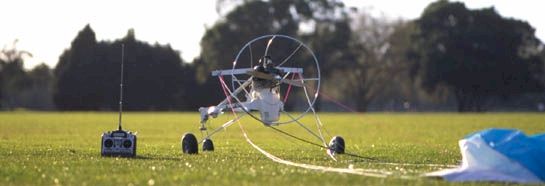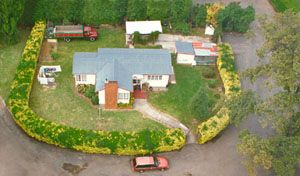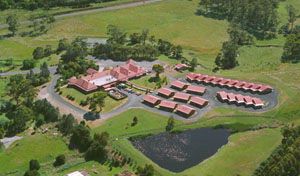

| An Unusual Design |

The Right Machine For The Right Job
As R/C aerial photography becomes more popular and commonplace, it
is only natural that people will begin experimenting with unusual radio-controlled
vehicles to obtain the best platform for certain types of photography
work.
We at Hi Cam have been using a helicopter for the past five years, and it has been a hard-working, faithful machine, capable of taking off virtually anywhere. It is excellent for still photos, and action video shots using an on-board camcorder. We would never give up using the helicopter, as it is a great way to take stills, and stills seem to be the biggest slice of the market, in Australia at least. If you want a steady supply of work, you can't beat stills!
Another Kind Of Photography
However, a new possibility has arisen regarding the kind of work we
might get involved in. After hearing expressions of interest by some television
industry professionals, we've had good reason to look seriously into the
kind of aerial video they really love to use in television: extremely
smooth, graceful fly-over footage.
This is quite hard to do with most radio-controlled vehicles because of their low inertia and resultant twitchy nature… they're better for fast action stuff. We can help the situation by using a wide-angle lens, which reduces the apparent instability in the shot. The other trick is to design a vehicle that has a great deal of natural stability. Here is a design we've been working on:
 The
Powered Parachute - A Test In Perseverance
The
Powered Parachute - A Test In Perseverance
A parachute should be stable, shouldn't it? The idea of pendulum stability
is at the heart of this concept. Might this turn out to be the ideal platform
for our smooth shots? It would certainly be nice and slow. To build a
radio-controlled powered parachute for this purpose really is a journey
into the unknown. We're aware that these things are in existence, although
much more rare than the full-sized people-carrying versions.
We began our stab in the dark by looking at some existing designs. Finding them instructive but unsuitable, we built our own design, powered by a Zenoah G23 petrol engine, and using giant servos to pull on the parachute's steering lines. After a lengthy period of building, it was time to take it to the field for the first flight. The machine sped across the grass, lifted off in spectacular fashion, and then did a barrel roll into the ground!
It turned out that the torque reaction had rotated the vehicle, with the parachute allowing this to happen, letting one side of its lines follow that side of the vehicle down. We have now fitted a cross-bracing system on the rigging to give roll stability, using an idea borrowed from NASA's new X-38, an emergency crew return vehicle for the International Space Station. Testing is continuing through August and September 2000.
 It's
All Good Fun
It's
All Good Fun
Whether either of these unusual designs achieves our goal, remains
to be seen. Details will be available on the Hi Cam web site. However,
one thing's for sure: if you own a model plane or helicopter, you have
an excellent platform for doing aerial stills and video. There are a lot
of excellent sites on the Internet to inspire and help you on your way.
Good luck!
Postscript
The powered parachute design has been shelved for the time being,
and instead our energies have been focussed on a design that is essentially
a small version of a powered hang glider. It has shown great stability
in flight, and has been tested with a simulated camcorder payload. Interestingly,
it can be hand-launched and retrieved.
Web Site: HiCam Aerial Photography
(These articles first appeared on the Hi Cam web site
and have been reproduced with the owner's permission).